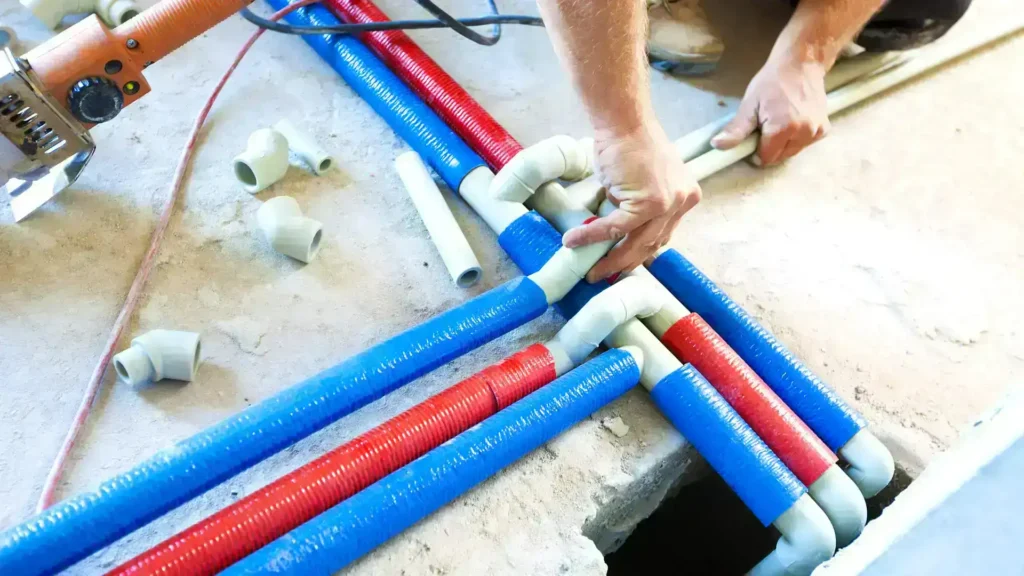The water freezing within a pipe causes said pipe to freeze. This takes place with a drop in temperature. A frozen pipe means an impediment to water flow. A burst pipe can cause severe damage.
You must have thought about freezing pipes in the winter. Cold temperatures can freeze pipes before one realizes it; even a slight delay in protecting them can lead to serious trouble. Hence, awareness of these risks keeps you prepared.
Pipes can freeze within a few hours under extreme cold conditions. The freeze time depends on temperature and insulation. Pipes without insulation freeze faster than those with insulation. Precautions can be taken to avoid freezing.
What Causes Pipes to Freeze?

Exposure to cold temperatures for long enough causes pipes to freeze. Remember the critical temperature of 32 degrees Fahrenheit (0 degrees Celsius). However, pipes are especially at risk when the temperature falls below 20 degrees Fahrenheit (-6.7 degrees Celsius); in such situations, unprotected pipes may freeze within only 2 to 6 hours.
Average Time for Freezing
An ordinary homeowner should thus expect unguarded pipes to freeze anywhere from six to eight hours once temperatures drop below 20 degrees Fahrenheit. Slightly above 32 degrees Fahrenheit, freezing may take up to 12 hours.
Signs That Pipes Are Freezing
Homeowners should keep a close watch for signs that their pipes may be freezing, including these common indicators:
- Reduced Water Flow: If you are experiencing a reduction in the pressure or flow of the water from your faucets, it might suggest that ice could form within your piping.
- Frost on Pipes: When frost collects on exposed pipes, it indicates the risk of freezing.
- Unusual Noises: Gurgling and banging sounds in your plumbing systems indicate water is having trouble passing through the ice blockage.
What Happens When Pipes Freeze?
If water in a pipe freezes, it expands. The expansion of water creates pressure against the pipe, and if the pressure generated exceeds the pipe’s ability to contain it, then the pipe will rupture. Ruptured pipes can cause severe water damages and costly repairs; therefore, it is important to address frozen pipes before they become ruptured.
Preventing Frozen Pipes
The necessity of preventing frozen pipes becomes evident for a safe and useful home during winter seasons. Specific measures can be taken:
- Insulate Pipes: Insulation should be placed around exposed pipes in unheated areas of the house. Whether using foam insulation sleeves or heat tape, the purpose is to keep warm.
- Keep Thermostat Consistent: A home should be maintained at a consistent temperature, particularly under very cold circumstances. Avoid setting the thermostat too low when sleeping or away.
- Let Faucets Drip: During extreme colds, letting faucets run very slightly actually helps keep the water moving through the pipes and prevents freezing.
- Seal Cracks and Openings: Check your house for any openings or cracks that air might penetrate, and seal these cracks or openings with caulk or insulation.
- Open Cabinet Doors: Open the doors of cabinets if the plumbing runs in them (such as the kitchen sink) to give warm air from the house a chance to circulate the pipes.
What To Do If Your Pipes Freeze
If you suspect that your pipes have frozen, it’s important not to wait too long before taking action:
- Turn Off Water Supply: Shut off the water at the main supply immediately to avoid flooding in case of a bursting pipe.
- Apply Heat: Use a hair dryer, heating pad, or low heat from a space heater to melt the ice near the frozen section of the pipe. Never use an open flame, which is a fire hazard.
- Check All Faucets: Open all the faucet taps connected to the frozen pipe. This will relieve pressure and let water flow after thawing.
- Call a Professional: If you cannot locate the frozen area or suspect damage may have already been done, call a plumber.
Factors That Impact Whether Your Pipes Will Freeze
- Low Temperatures: The freezing risk for pipes occurs when the temperature falls below 32°F (0°C) with greater likelihood under 20°F (-6.7°C); a few hours-long exposure to the cold increases this risk.
- Inadequate Insulation: Pipes without insulation, especially in unheated areas such as basements, crawl spaces, attics, or exterior walls, are excellent for freezing.
- Temperature Fluctuations: Rapid temperature alterations can cause the pipe to dent or crack, increasing its freezing or bursting potential.
- Pipe Material: Metals (copper or steel) will conduct heat away from the water faster than plastic (PVC or PEX), making them more prone to freezing. However, both types can freeze under extreme circumstances.
- Water Flow: Static water is more likely to freeze than moving water; letting the faucet drip during severe cold helps reduce freezing.
- Pipe Location: Pipes in unheated or unprotected areas (e.g., attics, garages, exterior walls) are at higher risk. Openings or cracks near pipes permit cold air infiltration, further hastening freezing.
- Wind Chill: Wind increases the rate of heat loss from any exposed pipe, especially those near drafts or gaps in the walls or floors.
- Thermostat Settings: Keeping the temperature within should stay low (below 55°F/13°C), increasing the freeze risk. Stable heating is beneficial in protecting pipes.
By fixing these factors—insulating pipes, sealing gaps, keeping water flowing, and maintaining temperature indoors—you can significantly minimize the chances of frozen pipes come winter.
Conclusion
Pipes can start freezing in at least six hours when the temperature drops to around 20°F (-6°C), which varies with insulation, wind chill, and pipe location. Pipes that are exposed freeze faster than those that are insulated or indoors. If it continues to be cold for several days, the chances of freezing increase. A small trickle of water run from a faucet can help slow freezing. Insulation with heating helps to prevent frozen pipes.
FAQs
Q1. Is it okay to let frozen pipes thaw out on their own?
No, it is not recommended because there is a danger of them breaking open if the pressure gets too high, creating water damage.
Q2. What is the lowest house temperature before pipes freeze?
Freezing can start when indoor temperatures hit below 32°F (0°C). However, at temperatures below 20°F (-6.7°C), the risk is much higher.
Q3. Can freeze pipes, explode?
Yes, pipes can freeze without bursting. However, if frozen for too long, they may eventually burst due to increased pressure.
Q4. Will shutting off water keep pipes from freezing?
Shutting off the water will not prevent pipes from freezing. It can help minimize damage if they do freeze and burst.
Q5. How long does it take for pipes to thaw naturally?
Pipes can take several hours to thaw naturally, depending on the temperature and insulation. Using heat sources can speed up this process significantly.

